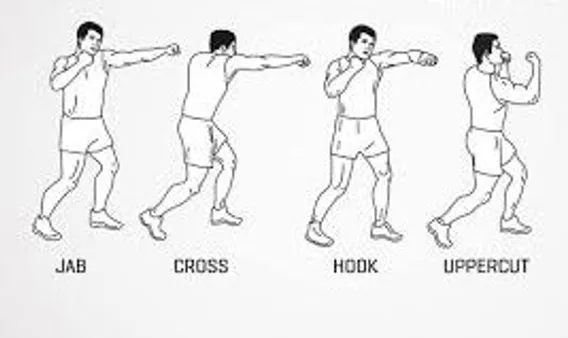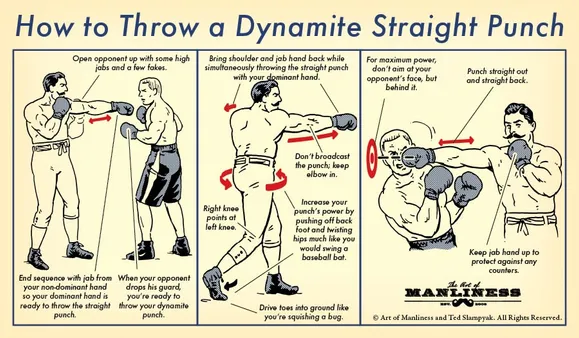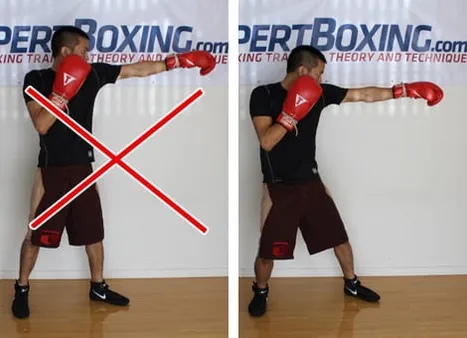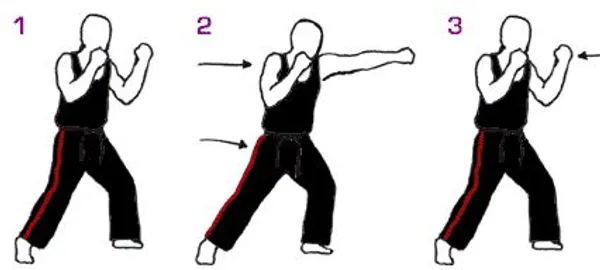Table of Contents
Welcome to Kizworld's comprehensive guide on How to do a jab, a fundamental boxing punch that lays the foundation for success in the ring. Often overlooked in its simplicity, the jab is a versatile tool that controls distance, sets up combinations, and scores points. Whether you're a seasoned boxer or just starting your journey, mastering the jab is essential for unlocking your full potential. In this guide, we'll break down the mechanics of the jab, common mistakes to avoid, and provide tips for improvement, transforming you into a jabbing maestro.
How to Do a Jab: Unleash Powerful and Accurate Punches in Boxing
I. How to Throw a Jab: A Step-by-Step Guide
How to Throw a Jab: A Step-by-Step Guide
1. Stance
- Begin with your feet shoulder-width apart, knees slightly bent.
- Lean forward slightly from the waist, keeping your back straight.
- Your front foot should be pointing straight ahead, while your back foot should be turned out slightly.
- Raise your non-dominant hand to your chin for protection.
2. Footwork
- To throw a jab, step forward with your front foot, landing on the ball of your foot.
- As you step, simultaneously pivot your back foot so that it is now pointing straight ahead.
- Keep your weight distributed evenly between your front and back foot.
3. Hand Position
- Your jab should start with your fist cocked back near your shoulder, palm facing down.
- As you step forward, extend your arm and snap your fist forward, rotating your wrist so that your palm faces down when the punch lands.
- Keep your elbow tucked in close to your body.
4. Throwing the Jab
- As you extend your arm, exhale sharply and focus on driving your fist through the target.
- Keep your shoulder relaxed and your arm straight throughout the punch.
- Retract your fist quickly after landing the jab, bringing it back to your chin for protection.
To improve your jab, practice these exercises:
- Shadowboxing: Practice throwing jabs in front of a mirror to get a feel for the movement.
- Hitting the heavy bag: This is a great way to develop power and accuracy in your jab.
- Working with a partner: Have a partner hold focus pads so you can practice landing your jab on a moving target.
With practice, you'll be able to throw a quick, powerful jab that will help you control the distance and set up your other punches.
II. Common Mistakes When Throwing a Jab
- Stepping too far forward: When you step too far forward with your jab, you leave yourself open to counterpunches.
- Leaning too far forward: Leaning too far forward makes you top-heavy and vulnerable to being knocked off balance.
- Not rotating your wrist: When you don't rotate your wrist, your punch will land with less power and accuracy.
- Not keeping your elbow tucked in: Keeping your elbow tucked in helps protect your face from counterpunches.
- Retracting your fist too slowly: Retracting your fist too slowly leaves you open to counterpunches.
III. Tips for Improving Your Jab
- Practice regularly: The more you practice your jab, the better it will become.
- Focus on technique: Make sure you're using proper technique when throwing your jab, as this will help you generate more power and accuracy.
- Get feedback: Ask your trainer or coach to give you feedback on your jab so you can improve your technique.
- Be patient: It takes time to develop a good jab, so be patient and keep practicing.
IV. Mastering the Jab: Techniques and Variations
Mastering the Jab: Techniques and Variations
Single Jab
- A fundamental jab, thrown with the dominant hand.
- Keep your elbow tucked in to protect your face.
- Extend your arm quickly, with your fist rotating to land with your knuckles.
Double Jab
- A combination of two jabs, thrown in quick succession.
- The first jab is a setup, the second jab is the power punch.
- Keep your rhythm consistent and your hands close to your face.
Triple Jab
- A combination of three jabs, thrown in rapid succession.
- Similar to the double jab, but with an extra punch for emphasis.
- Be careful not to overextend your arm or leave yourself open to a counterattack.
Long Jab
- A jab that is thrown from a long distance, keeping the opponent at bay.
- Use your reach to your advantage, and keep your opponent off balance.
- Good footwork is essential for maintaining your distance and landing long jabs effectively.
Snap Jab
- A quick, short jab that is used to sting the opponent and set up other punches.
- Retract your fist quickly after landing, making it difficult for your opponent to counter.
- The snap jab is a great tool for keeping your opponent on their toes and preventing them from getting too close.
Flick Jab
- A jab that is thrown with a flick of the wrist, rather than a full extension of the arm.
- The flick jab is a fast and evasive punch that is difficult to see coming.
- This makes it a good option for catching your opponent off guard or setting up other punches.
Martial arts can be a great way to develop your jab and other striking techniques, while also improving your overall fitness and coordination.
Benefit | Description |
Control Distance | Keep opponents at bay and dictate the pace of the fight |
Set Up Combinations | Open up opportunities for powerful follow-up punches |
Score Points | Accumulate points by landing clean jabs |
Sting Opponent | Cause pain and distraction, disrupting their focus |
V. Jabbing for Beginners: Common Mistakes to Avoid
Jabbing for Beginners: Common Mistakes to Avoid
Mistake 1: Not Keeping Your Jab Hand Relaxed
A common mistake among beginners is gripping the jab hand too tightly. This can lead to tension in the arm and shoulder, which will slow down your jab and make it less powerful. Keep your jab hand relaxed and let it flow freely from your shoulder.
- Keep your fingers loose and slightly curled.
- Don't grip the fist too tightly.
- Let your arm hang naturally from your shoulder.
Mistake 2: Not Extending Your Arm Fully
Another common mistake is not extending your arm fully when you jab. This will result in a weak and ineffective jab that won't do much damage. Make sure to extend your arm fully and snap your fist forward at the end of the punch.
- Extend your arm fully from the shoulder.
- Snap your fist forward at the end of the punch.
- Keep your elbow locked and your wrist straight.
Mistake 3: Not Rotating Your Hips
When you jab, you should be rotating your hips to generate power. This will help you to drive the punch through your opponent and make it more effective. Make sure to rotate your hips as you step forward with your lead foot.
- Rotate your hips as you step forward with your lead foot.
- Keep your shoulders square to your opponent.
- Don't over-rotate your hips, as this can leave you open to a counterattack.
Mistake 4: Not Aiming for the Right Target
When you jab, you should be aiming for your opponent's face or body. Don't just throw jabs for the sake of throwing them. Make sure you're aiming for a specific target and that you're trying to land your punches with precision.
- Aim for your opponent's face or body.
- Don't just throw jabs for the sake of throwing them.
- Be precise with your punches and try to land them with power.
Mistake 5: Not Using Your Jab to Set Up Other Punches
The jab is a great way to set up other punches. By jabbing your opponent, you can create openings for your power punches. For example, you can jab your opponent's face to set up a right cross or you can jab their body to set up a left hook.
- Use your jab to set up other punches.
- Create openings for your power punches by jabbing your opponent.
- Be creative and experiment with different combinations.
By avoiding these common mistakes, you can improve your jabbing technique and become a more effective boxer. Remember, practice makes perfect. The more you practice your jab, the better you will become at it.
VI. Jabbing in Different Situations: Offense, Defense, and Combinations
Jabbing in Different Situations: Offense, Defense, and Combinations
The jab is a versatile tool that can be used in various situations in boxing. Whether you're on the offensive or defensive, the jab can help you control the pace of the fight, set up combinations, and score points.
VII. Offense
- Establishing Range: The jab is a great way to establish range and keep your opponent at bay. By keeping your opponent at a distance, you can control the pace of the fight and prevent them from getting close enough to land their own punches.
- Setting Up Combinations: The jab can be used to set up combinations by creating openings for your other punches. For example, you can throw a jab to your opponent's head and then follow it up with a cross to the body.
- Scoring Points: The jab is a relatively easy punch to land, and it can be used to score points throughout the fight. Even if the jab doesn't knock your opponent down, it can still add up over the course of the fight and give you an advantage on the scorecards.
VIII. Defense
- Blocking Punches: The jab can be used to block your opponent's punches. By keeping your jab up, you can protect your face from your opponent's punches and prevent them from landing clean shots.
- Creating Distance: The jab can be used to create distance between you and your opponent. By jabbing your opponent, you can push them back and keep them at a distance where they can't hit you.
- Countering: The jab can be used to counter your opponent's punches. For example, you can jab your opponent as they're throwing a punch, or you can jab them as they're recovering from a punch.
IX. Combinations
The jab is a versatile punch that can be combined with other punches to create devastating combinations. Some common jab combinations include:
- Jab-Cross: This is a basic two-punch combination that is easy to land and can be very effective. The jab is used to set up the cross, which is a more powerful punch.
- Jab-Uppercut: This is a two-punch combination that is used to attack your opponent's head. The jab is used to set up the uppercut, which is a powerful punch that can knock your opponent out.
- Jab-Hook: This is a three-punch combination that is used to attack your opponent's body. The jab is used to set up the hook, which is a powerful punch that can hurt your opponent's ribs or liver.
These are just a few examples of the many combinations that can be created using the jab. The jab is a versatile tool that can be used in a variety of ways to help you win your boxing match.
X. Conclusion
As you continue to practice and refine your jab, you'll find it evolving into a versatile weapon in your boxing arsenal. Its simplicity and effectiveness make it a cornerstone of any successful boxer's game plan. Remember, the jab is not just about throwing punches; it's about controlling the tempo of the fight, dictating the terms of engagement, and setting the stage for your other punches to land. With dedication and perseverance, you'll transform your jab into a thing of beauty, a piston-like extension of your will that keeps your opponents at bay and opens up a world of possibilities for your offense. So, step into the ring, embrace the jab, and let it be your gateway to boxing greatness.